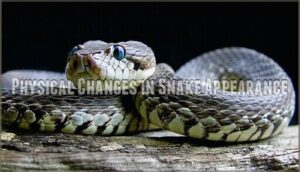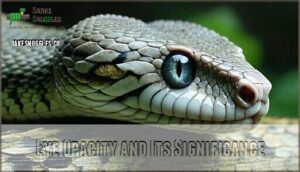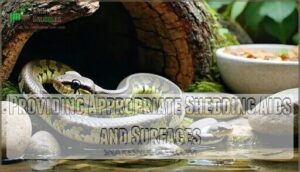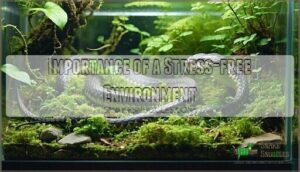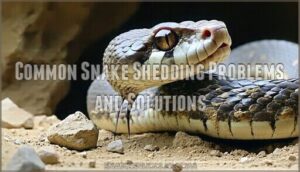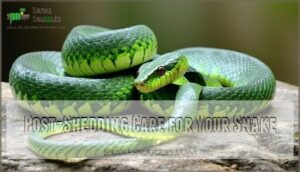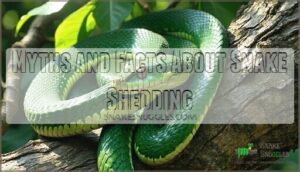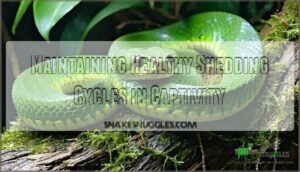This site is supported by our readers. We may earn a commission, at no cost to you, if you purchase through links.
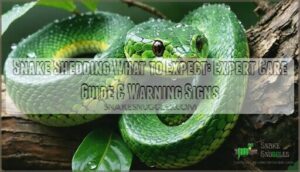
Your snake’s skin will appear dull and cloudy, almost like it’s wearing a foggy coat. The eyes turn milky blue or gray, creating what’s called "in blue" or "opaque" phase.
You’ll see decreased appetite and increased hiding behavior as your snake becomes more reclusive. The belly often takes on a pinkish hue, and your pet may rub against rough surfaces more frequently.
This pre-shed phase typically lasts 7-10 days before the actual shedding occurs. Understanding these signs helps you provide proper humidity and avoid unnecessary handling during this vulnerable time.
Table Of Contents
- Key Takeaways
- The Snake Shedding Process Explained
- Recognizing Signs of Impending Snake Shedding
- Creating an Ideal Environment for Snake Shedding
- Common Snake Shedding Problems and Solutions
- Post-Shedding Care for Your Snake
- Myths and Facts About Snake Shedding
- Maintaining Healthy Shedding Cycles in Captivity
- Frequently Asked Questions (FAQs)
- What are the stages of snake shedding?
- What should you do when your snake is shedding?
- How do snakes act when they are shedding?
- What does a snake do when it sheds?
- What to expect when your snake is shedding?
- How long should you leave a snake after shedding?
- Is it painful for snakes to shed?
- Do snakes act weird when shedding?
- How long does a typical snake shedding process take?
- Can snakes eat during the shedding process?
- Conclusion
Key Takeaways
- You’ll notice your snake’s skin becomes dull and cloudy with milky blue eyes during the 7-10 day pre-shed phase, signaling it’s time to increase humidity to 60-70% and avoid handling
- Your snake will refuse food and hide more during shedding, which is completely normal behavior—don’t force feeding or handling until the process is complete
- Provide rough surfaces like cork bark and water bowls for soaking to help your snake remove the old skin in one complete piece rather than patches
- After shedding, wait 24-48 hours before resuming normal handling and feeding, then examine the shed skin to ensure it came off completely without retained pieces on the tail or eyes during the pre-shed phase, and check for complete shedding
The Snake Shedding Process Explained
Snake shedding, or ecdysis, is a natural process where your snake replaces its entire outer skin layer in one complete piece.
Understanding this four-stage cycle will help you recognize when your snake needs extra care and know what changes to expect in their appearance and behavior.
Snake shedding, or ecdysis, is a natural process where your snake replaces its entire outer skin layer in one complete piece.
Understanding this four-stage cycle will help you recognize when your snake needs extra care and know what changes to expect in their appearance and behavior.
Stages of Ecdysis in Snakes
Snake ecdysis unfolds through four distinct snake shedding stages that mark your pet’s remarkable transformation journey.
Initial Shedding begins subtly with dull, faded skin and sometimes a pinkish belly. Your snake’s vibrant colors lose their luster, signaling the shedding timeline has started.
The dramatic Opaque Stage follows, where eyes turn cloudy blue and vision becomes impaired. This "in-blue" phase makes handling risky since your snake can’t see clearly.
During the "in-blue" phase, your snake becomes temporarily blind—making every interaction a potential threat.
During the Clearing Phase, eye opacity fades and your snake prepares for the final act. This transitional stage often confuses new owners.
Final Shedding arrives when your snake rubs against surfaces, peeling off the complete skin like removing a sock.
Key ecdysis characteristics include:
- Phase Duration varies from days to weeks per stage
- Younger snakes cycle through faster than adults
- Environmental factors influence snake shedding timeline
- Each stage brings distinct visual changes
- Complete transformation reveals vibrant new skin underneath.
This natural process guarantees healthy growth and parasite removal.
Frequency of Shedding in Different Snake Species
Understanding shedding frequency helps you anticipate your snake’s needs.
Juvenile vs. Adult patterns differ substantially—young snakes shed every 4-6 weeks due to rapid snake growth, while adults shed every 6-12 weeks.
Ball pythons exemplify typical species shedding rates: juveniles every month, adults quarterly.
Corn snakes follow similar timelines, though snake age gradually extends intervals.
Boa constrictors can shed monthly as babies, dropping to bi-monthly as adults.
Each snake species displays unique shedding frequency patterns, making species-specific knowledge essential for proper care expectations.
Adult ball pythons, for instance, experience shedding every 4-6 weeks.
Factors Influencing Snake Shedding Cycles
Several key elements determine how often your snake sheds its skin. Age and shedding frequency connect directly—juveniles outgrow their skin rapidly, requiring snake shedding every few weeks, while adults shed seasonally. Species variation also matters substantially.
Young snakes shed monthly while adults shed seasonally—growth drives the timing, not your care routine.
Snakes shed to facilitate growth and eliminate parasites.
Consider these critical factors affecting your shedding cycle:
- Environmental conditions like humidity and temperature must match species requirements
- Nutritional impact from diet quality directly influences skin health
- Health status affects regularity—illness disrupts normal patterns
- Snake growth spurts trigger more frequent molts in younger animals
- Snake nutrition deficiencies can delay or complicate the process
Getting these basics right guarantees predictable, healthy shedding patterns for your snake.
Duration of The Complete Shedding Process
The complete snake shedding process duration ranges from 5-14 days, depending on multiple factors.
Your snake’s age influence plays a substantial role—juveniles complete their shedding cycle stages faster due to rapid growth, while adults take longer.
Species variation also matters, as ball pythons typically finish within 7-10 days compared to larger species requiring two weeks.
Environmental impact directly affects the shedding timeline:
- Humidity levels below 50% extend the snake shedding process duration markedly
- Temperature fluctuations can disrupt normal shedding cycle progression
- Poor air circulation creates conditions that complicate skin removal
Health factors determine how efficiently your snake navigates the shedding process.
Well-nourished snakes with proper care complete their shedding cycle smoothly, while stressed or unhealthy individuals may experience prolonged timelines.
Recognizing Signs of Impending Snake Shedding
Recognizing when your snake is about to shed isn’t guesswork—there are clear physical and behavioral signs that signal the start of ecdysis.
Understanding these early warning signs helps you provide the right care and avoid unnecessary stress for both you and your snake during this natural process, which is crucial for a smooth ecdysis.
Physical Changes in Snake Appearance
Recognizing when your snake’s about to shed starts with watching for distinctive physical changes that unfold over several days. Skin dullness appears first – your snake’s vibrant colors fade to a muted, lackluster appearance that signals the snake shedding signs have begun.
The most dramatic change occurs during the inblue stage, when eye cloudiness develops as fluid builds between old and new skin layers. Your snake’s eyes turn milky blue or gray, creating opaque eyes that markedly impair vision. Belly coloration may shift to pinkish tones, though this varies among individuals.
Scale appearance becomes noticeably different as the outer layer loosens. Skin feels rougher and may develop subtle wrinkles, particularly around the neck area. The overall effect creates a ghostly, faded look that’s unmistakable once you’ve seen it.
After days in blue, the clearing up phase begins when eyes gradually return to normal clarity, preparing for the final shedding process when shed uniformity determines success.
Behavioral Changes During Pre-shed Phase
Temperament shifts signal your snake’s approaching shed cycle, creating noticeable changes in daily routines and interactions.
Key behavioral changes to monitor:
- Hiding Behavior – Your snake retreats to secure areas, avoiding open spaces and staying concealed for extended periods
- Appetite Changes – Food refusal becomes common as energy redirects toward the shedding process and metabolism slows
- Increased Irritability – Defensive strikes and heightened stress responses occur due to impaired vision and vulnerability
Activity reduction accompanies these snake shedding signs.
Defensive behavior peaks during this phase, making handling inadvisable until completion.
Eye Opacity and Its Significance
Your snake’s cloudy eyes signal the Blue Phase has begun.
The Blue Phase involves fluid buildup that separates old spectacles from new ones underneath, causing temporary shedding blindness.
This spectacle clarity loss makes your snake defensive and prone to striking.
Albino eyes show less pronounced cloudiness but still indicate shedding progress.
The milky appearance lasts 3-5 days before clearing again.
During this phase, your snake can’t see properly, so avoid handling.
Eye caps will shed with the rest of the skin.
Retained spectacles may occur if humidity is too low.
This cloudy eyes stage marks the halfway point of your snake’s shedding cycle.
Changes in Snake’s Appetite and Activity Levels
During pre-shed, your snake’s eating habits shift dramatically.
Snake feeding stops as appetite vanishes completely.
Reduced activity becomes obvious as your pet seeks hiding behavior in dark corners.
Increased nervousness leads to defensive strikes when disturbed.
These snake shedding signs indicate snake behavior changes signaling snake shedding approaches.
Respect this natural process by minimizing handling during this vulnerable period.
Creating an Ideal Environment for Snake Shedding
Creating the right environment during your snake’s shedding period can make the difference between a smooth, complete shed and frustrating complications that require intervention.
You’ll need to adjust humidity levels, maintain proper temperatures, and provide appropriate surfaces while minimizing stress factors that could interfere with this natural process, ensuring a smooth shed.
Optimal Humidity Levels for Shedding Snakes
Most successful keepers understand that humidity monitoring separates clean sheds from stuck disasters.
Maintain species-specific humidity levels between 50-70% using reliable hygrometers for accurate readings. Consistent hydration importance can’t be overstated during this vulnerable period.
Using a quality reptile hygrometer is essential for proper monitoring.
- Create humid hides with dampened sphagnum moss for localized moisture control
- Use misting techniques sparingly to avoid oversaturating the enclosure design
- Monitor species variation requirements since ball pythons need different levels than corn snakes
- Adjust shedding humidity gradually rather than making sudden environmental changes
Temperature Requirements During Shedding
Maintaining proper temperatures during snake shedding guarantees your pet’s comfort and success throughout this natural process.
Your snake needs consistent warmth to effectively loosen old skin layers and complete ecdysis without complications.
- Set your basking spot between 85-90°F – This warm zone helps separate skin layers naturally
- Maintain nighttime temps around 75-80°F – Slight drops won’t interfere with shedding
- Use reliable heating methods like ceramic emitters – Consistent heat without disruptive lighting
- Install thermostat control for accuracy – Prevents dangerous temperature fluctuations that cause shedding problems
Temperature gradient stability becomes vital during this vulnerable period when proper humidity and snake care work together for successful skin removal.
Providing Appropriate Shedding Aids and Surfaces
Your snake needs the right tools to shed successfully. Rough surfaces like cork bark, natural wood, and textured rocks provide essential friction for initiating snake shedding.
Water bowls large enough for soaking help loosen stubborn skin. Humid hides filled with damp moss create moisture-rich retreats that boost proper humidity levels.
Substrate choice matters—cypress mulch and coco husk retain moisture better than dry options. Position multiple shedding solutions throughout your snake enclosure so your snake can choose preferred spots.
Avoid sharp objects that might damage new skin. Enclosure size should accommodate various aids while maintaining ideal snake shedding humidity levels.
Maintaining ideal humidity levels is essential for a healthy shed.
Importance of a Stress-free Environment
Creating a calm atmosphere for your snake during shedding isn’t just helpful—it’s essential.
Stress disrupts natural shedding behavior and can lead to complications like stuck shed or incomplete molts.
- Reduced Handling: Avoid unnecessary contact during the entire shedding cycle to prevent additional snake stress
- Safe Hides: Provide multiple secure hiding spots throughout the snake enclosure for comfort and security
- Quiet Environment: Keep noise levels low and limit disturbances around the enclosure during shedding precautions
- Minimize Interaction: Restrict feeding attempts and routine maintenance to essential tasks only during this period
- Consistent Routine: Maintain regular lighting schedules and temperature cycles to support natural shedding behavior
Common Snake Shedding Problems and Solutions
Even the healthiest snakes can experience shedding complications that require your attention and intervention.
Understanding how to identify and address stuck sheds, retained eye caps, and other common issues will help you maintain your snake’s health and prevent serious complications.
Incomplete or Stuck Sheds
Even with proper environmental conditions, some snakes experience incomplete shed or dysecdysis—where old skin doesn’t come off cleanly. You’ll recognize this problem when patches of dull, flaky skin remain stuck to your snake’s body, particularly around the tail tip, toes, or nose area.
Three main causes of shedding complications:
- Humidity Issues – Inadequate moisture levels prevent natural skin loosening
- Lack of Shedding Aids – Missing rough surfaces for rubbing assistance
- Underlying Health Problems – Nutritional deficiencies or parasites affecting skin quality
Never attempt removing retained shed yourself, as this can tear healthy skin underneath. Instead, focus on Preventative Measures like maintaining 60-70% humidity and providing textured surfaces. Also, consider using a quality shedding product to help ease the process.
Dietary Impact plays a role too—malnourished snakes often struggle with complete sheds. If problems persist after environmental adjustments, seek Veterinary Care immediately. Professional removal prevents infection and scarring that DIY attempts often cause.
Retained Eye Caps and How to Address Them
When your snake has retained eye caps, you’ll notice persistent cloudiness or wrinkled spectacles after shedding. This corneal exposure problem requires careful attention.
Humidity and Caps are directly linked—low moisture causes most retention issues. For Eye Cap Prevention, maintain proper humidity levels around 70% and provide adequate water sources.
Boost environmental moisture through damp hides or gentle misting. A lukewarm soak can soften stuck cap removal naturally.
However, never attempt manual removal yourself—this risks permanent damage to delicate snake eyes. Professional Vet Intervention guarantees safe extraction without injury.
Monitor your snake’s shedding retained eye caps patterns closely, as repeated problems indicate husbandry adjustments needed for future Post-Shed Care success.
When to Seek Veterinary Assistance
Vigilance during ecdysis becomes essential when your snake’s health deteriorates beyond normal shedding challenges.
Seek professional veterinary care immediately if you notice these warning signs:
- Stuck Sheds restricting blood circulation around tail or body
- Eye Caps remaining after multiple shed cycles
- Skin Lesions or infections developing from dysecdysis
- Abnormal Sheds occurring too frequently or incompletely
- Behavior Changes like persistent appetite loss or lethargy
Don’t hesitate—your snake shedding veterinarian can prevent serious complications from escalating.
Low humidity can cause incomplete shedding and other issues.
Post-Shedding Care for Your Snake
After your snake completes its shed, you’ll need to inspect both the discarded skin and your pet for any health concerns.
This post-shedding period is essential for ensuring your snake returns to normal feeding and behavior patterns while monitoring for potential complications.
Examining The Shed Skin for Abnormalities
Once any immediate shedding problems are resolved, you’ll want to examine the shed snake skin carefully for signs that might indicate health concerns.
Look for scale imperfections like missing or damaged scales, variations in skin thickness that feel unusually thin or thick, and color abnormalities that differ from your snake’s normal patterns.
Check the shed consistency – a healthy shed should come off in one complete piece during the shedding process.
Search for parasite evidence such as tiny moving specks, unusual spots, or strange textures on the reptile skin.
These examinations provide valuable insights into your snake health status.
Proper Handling After Shedding
Once your snake completes shedding, patience becomes your best friend.
Wait 24-48 hours before any snake handling to allow proper adjustment.
Your reptile care routine should include these post-shed priorities:
- Gentle handling with slow movements to reduce stress
- Skin examination for retained fragments or wounds
- Hydration check ensuring fresh water availability
- Enclosure cleaning to maintain ideal snake health conditions.
This recovery period lets your snake owner confidence build while supporting natural snake shedding care processes through thoughtful reptile care practices.
Adjusting Feeding Schedules Post-shedding
After your snake’s successful shed, you’ll notice renewed appetite within 24-48 hours.
Resume normal snake feeding schedules with appropriate prey size – fresh skin means improved digestion ease. Ball python feeding typically returns to weekly intervals, while smaller species may feed more frequently.
Monitor feeding frequency based on your snake’s response. Make certain proper hydration importance by maintaining fresh water.
Watch for any feeding precautions like prey refusal, which occasionally happens post-shed. Some owners find that offering erratic feeding patterns can stimulate a stronger feeding response.
Monitoring for Potential Health Issues
Beyond the immediate post-shedding period, you’ll need to maintain vigilant observation for health complications that can develop. Understanding these warning signs empowers you to catch problems before they escalate into serious conditions.
Monitor your snake for these critical health indicators:
- Scale rot symptoms – Look for darkened, soft, or raised scales that indicate bacterial infection from excessive moisture
- Dysecdysis causes – Watch for incomplete sheds due to low humidity, poor nutrition, or underlying illness requiring intervention
- Dehydration signs – Check for wrinkled skin, sunken eyes, or retained shed pieces that signal insufficient moisture levels
- Parasite detection – Examine shed skin analysis for unusual markings, mites, or abnormal scale patterns indicating external parasites
- Stuck shed complications – Identify retained shed on tail tips, eye caps, or between scales that can restrict blood flow
Regular shed skin analysis helps detect dysecdysis and other snake shedding problems early, allowing you to implement appropriate snake shedding solutions promptly.
Myths and Facts About Snake Shedding
You’ve likely encountered various myths about snake shedding that can lead to unnecessary worry or improper care decisions.
Understanding the scientific facts behind ecdysis helps you provide better care and recognize normal versus problematic shedding patterns, which is crucial for proper care.
Debunking Common Misconceptions About Shedding
Many misconceptions surround snake shedding, causing unnecessary worry for new owners. **Shedding Painful?
** No—this natural process feels like removing tight clothing, not painful at all. Your snake experiences mild discomfort at most.
Shedding Frequency isn’t controlled by feeding schedules or handling habits. Age and species determine how often snakes shed, with juveniles shedding more frequently than adults due to rapid growth.
Shedding Coloration changes don’t signal illness. When your snake’s eyes turn cloudy blue, that’s normal preparation for snake shedding. These physical changes indicate healthy skin renewal, not snake shedding problems.
Handling Shedding snakes won’t disrupt their natural cycle, though minimizing stress helps. Proper humidity levels are also extremely important. Stuck Sheds and retained shed (dysecdysis) occur mainly due to low humidity, not because you touched your snake. Most snake shedding issues resolve with proper environmental conditions rather than intervention.
Scientific Explanations for Shedding Behavior
Your snake’s shedding process unfolds through precise Hormonal Influence and Cellular Mechanisms.
Growth hormones trigger ecdysis while Enzymatic Action dissolves connections between old and new skin layers.
Lymphatic Function helps fluid accumulate, separating layers for easier removal.
The shedding process involves keratin production creating fresh scales underneath.
Temperature changes, growth spurts, and photoperiods activate these biological triggers.
This snake shedding behavior serves multiple Evolutionary Purpose functions beyond simple skin renewal.
Understanding these mechanisms helps you recognize normal patterns:
- Your snake isn’t choosing when to shed—biology controls the timing
- Cloudy eyes result from lymphatic fluid, not illness or stress
- Multiple hormone systems coordinate this complex transformation process
- Environmental cues fine-tune your snake’s natural shedding rhythm
Shedding’s Role in Snake Growth and Health
Understanding snake shedding reveals nature’s remarkable design for snake health.
The shedding process serves three key functions that keep your pet thriving.
Skin renewal through ecdysis frequency allows growth spurts in young snakes while maintaining skin integrity throughout life.
Your snake literally outgrows its old skin like a tight jacket.
Parasite removal eliminates mites and bacteria that accumulate on outer snake scales.
Additionally, shedding supports injury recovery by replacing damaged tissue with fresh, healthy scales underneath.
This natural mechanism guarantees the best sensory function and protection against environmental threats.
Variations in Shedding Among Different Snake Species
Different snake species exhibit distinct shedding patterns that’ll help you better care for your pet.
Your ball python won’t follow the same timeline as your corn snake, and recognizing these differences prevents unnecessary worry.
Species-specific shed frequency varies dramatically across the snake world.
Juvenile ball pythons shed monthly, while adult boa constrictors might only molt twice yearly.
These variations reflect each species’ unique biology and growth requirements.
Several factors create these reptile shedding differences:
- Growth rate variations – Fast-growing species like corn snakes shed more frequently
- Regional variations – Desert species often shed less due to slower metabolism
- Arboreal shedding patterns differ from ground-dwelling species due to activity levels
- Aquatic shedding occurs more regularly in water-loving species
- Shed difficulty increases with age and species-specific scale structure
Your snake’s molting schedule depends on genetics, habitat, and individual health.
Understanding your specific snake species helps you anticipate normal shedding cycles and identify potential problems early.
Maintaining Healthy Shedding Cycles in Captivity
Maintaining ideal shedding cycles in captivity requires consistent attention to your snake’s environmental needs and overall health.
You’ll need to focus on proper nutrition, regular monitoring, and creating conditions that support natural shedding processes, which includes paying attention to overall health.
Proper Nutrition for Optimal Shedding
Beyond dispelling shedding myths, your snake diet forms the foundation for successful ecdysis.
Vitamin deficiencies in A, E, and B-complex directly cause poor sheds and compromised healthy skin. Quality whole prey provides complete nutrition, while supplement options like reptile multivitamins address dietary gaps.
Feeding frequency matters—juveniles need weekly meals, adults every 2-4 weeks. Prey quality affects keratin production in new skin layers.
Hydration importance can’t be overstated; dehydrated snakes struggle with incomplete sheds. Consistent nutrition supports snake health and ideal shedding cycles naturally.
Regular Health Check-ups and Their Importance
Your snake’s health check-ups serve as preventative care cornerstones for successful shedding cycles.
A qualified reptile veterinarian can identify potential problems before they disrupt your pet’s natural shedding process.
These routine examinations help maintain prime snake health through thorough assessments.
During veterinary visits, professionals evaluate multiple aspects of your snake’s condition:
- Parasite Detection – Screening for mites and internal parasites that interfere with healthy shedding
- Hydration Assessment – Checking moisture levels vital for flexible skin during ecdysis
- Scale Condition – Examining skin integrity and identifying early snake shedding signs
- Injury Checks – Documenting wounds or abrasions that could complicate the shedding process
- Behavioral Analysis – Discussing any unusual snake shedding observations you’ve noticed
Regular monitoring through professional snake health evaluations guarantees your reptile maintains consistent, problem-free shedding cycles throughout its lifetime.
Creating a Naturalistic Habitat for Snakes
Five key elements transform your snake’s living space into a shedding sanctuary. Enclosure Size directly impacts stress levels—larger spaces reduce anxiety during vulnerable shedding periods. Your Substrate Choice matters tremendously for maintaining proper snake shedding humidity levels. Cypress mulch and coconut fiber retain moisture better than aspen shavings.
To confirm a healthy shed, consider the variety of available shedding substrates. Naturalistic Decor provides essential rubbing surfaces. Cork bark, driftwood, and rough stones help your snake remove old skin effectively.
Establish a proper Temperature Gradient with basking spots at 88-92°F and cool zones at 78-80°F. Humidity Control requires constant attention—aim for 50-60% baseline humidity, increasing to 70-80% during shedding cycles.
| Habitat Feature | Shedding Benefit |
|---|---|
| Multiple hiding spots | Reduces stress during vulnerable periods |
| Rough textures | Natural rubbing surfaces for skin removal |
| Live plants | Maintains snake shedding environment humidity |
Your snake habitat becomes a health-supporting ecosystem when these environmental conditions work together, creating the perfect snake shedding substrate foundation.
Monitoring and Recording Shedding Patterns
Keeping detailed records transforms how you’ll understand your snake’s shedding process. Tracking shedding data logs reveals patterns that might otherwise go unnoticed, helping you anticipate your snake’s needs before problems arise.
Environmental correlations between humidity, temperature, and shed frequency analysis provide vital insights into your husbandry practices.
- Document each complete snake shedding cycle with dates and duration
- Record shed quality, noting any retained pieces or shedding signs
- Track environmental conditions during each snake shedding timeline
- Monitor growth rate tracking by measuring your snake between sheds
- Note behavioral changes and health indicator analysis observations
This systematic approach to shedding observations creates a valuable health record. You’ll spot deviations from normal patterns early, allowing for proactive adjustments to care routines before issues become serious, which is crucial for maintaining a healthy snake through husbandry practices and understanding the importance of growth rate tracking.
Frequently Asked Questions (FAQs)
What are the stages of snake shedding?
Though shedding seems alarming, it’s natural. You’ll observe four stages: pink belly with dull skin, blue-cloudy eyes phase, clearing stage, then actual shedding where old skin peels off completely.
What should you do when your snake is shedding?
Leave your snake alone during shedding to avoid stress and defensive strikes.
Don’t handle or feed them.
Maintain proper humidity and provide water bowls or rough surfaces to help the shedding process succeed, which can be crucial to avoid stress.
How do snakes act when they are shedding?
Like a hermit retreating into solitude, your snake becomes withdrawn and defensive during shedding. They’ll refuse food, hide constantly, and strike more readily due to cloudy vision impairing their sight.
What does a snake do when it sheds?
Your snake rubs its nose against rough surfaces to start peeling off the old skin.
It’ll work the skin off like removing a sock, ideally shedding everything in one complete piece.
What to expect when your snake is shedding?
Like a masterpiece revealing itself, your snake’s shedding journey unfolds in predictable stages.
Expect dull skin, cloudy blue eyes, decreased appetite, and increased hiding behavior.
The process takes 9-14 days, culminating in one complete skin shed, which is a complete transformation.
How long should you leave a snake after shedding?
After your snake completes shedding, wait 48-72 hours before handling or feeding. This allows them to destress, adjust to their new skin, and return to normal behavior patterns safely.
Is it painful for snakes to shed?
No, shedding isn’t painful for snakes.
It’s a natural process that relieves old, tight skin.
Your snake might feel some discomfort or irritation, which is why they rub against surfaces to help remove the shed skin.
Do snakes act weird when shedding?
Your snake transforms into a completely different creature during shedding.
They’ll become reclusive hermits, hiding constantly and refusing food.
Their cloudy eyes make them jumpy and defensive, often striking at perceived threats they can’t see clearly, which can be a defensive mechanism.
How long does a typical snake shedding process take?
You’ll typically see the complete shedding process unfold over 9-14 days.
It starts with subtle dulling, progresses through the dramatic "blue phase," then clears before your snake finally rubs off the old skin in one piece.
Can snakes eat during the shedding process?
Most snakes won’t eat during shedding cycles.
You’ll notice they refuse food days before starting the process.
Their impaired vision and stress levels make eating risky, so they naturally fast until completing the shed.
Conclusion
Understanding snake shedding what to expect transforms you from anxious reptile parent into confident caretaker—because apparently your snake thinks molting is more dramatic than a teenager’s wardrobe crisis.
You’ve learned to recognize pre-shed signs, create ideal conditions, and handle complications.
With proper humidity, appropriate surfaces, and patience, you’ll support healthy shedding cycles.
Remember to examine shed skin for completeness and monitor your snake’s behavior. This knowledge guarantees your pet thrives through each natural transformation.
- https://www.iowadnr.gov/news-release/2015-08-25/why-do-snakes-shed-their-skin
- https://www.petplace.com/article/reptiles/pet-health/small-pet-health/reptile-small-pet-health/dysecdysis-shedding-problems
- https://wholeeartheducation.com/snakes-shedding-skin/
- https://reptifiles.com/corn-snake-care-guide/sick-corn-snake-diseases-health/corn-snake-shedding/
- https://www.partridgepractices.co.uk/article/skin-shedding-in-snakes-everything-you-need-to-know-from-head-vet-darren-partridge/

